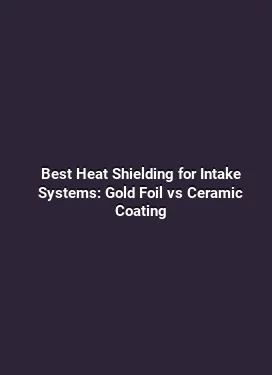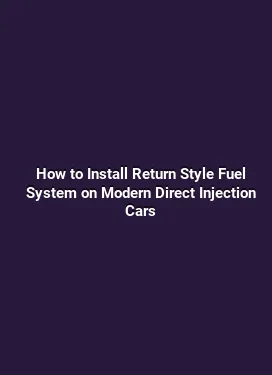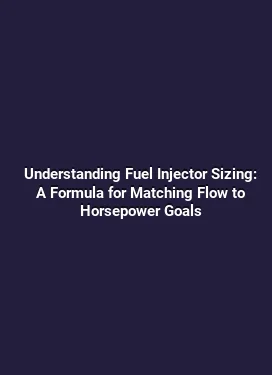The Ultimate Guide to Cold Air Intake vs. Short Ram Intake Performance Gains
Intake and fuel systems play a pivotal role in how an engine breathes, responds, and makes power across a wide range of driving conditions. When enthusiasts seek to extract every ounce of performance from a naturally aspirated or boosted setup, two popular aftermarket paths often surface: cold air intake (CAI) systems and short ram intake (SRI) systems. This guide delves into the mechanics, the expected gains under real-world driving, and the practical considerations that influence choice, installation, and long-term reliability. By examining airflow dynamics, pressure recovery, filtration, and tuning interactions, readers gain a nuanced understanding that goes beyond surface claims and marketing hype.
Foundations: How Intake Systems Influence Power and Torque

At the core, an intake system’s job is to deliver a clean, cool, and steady supply of air to the combustion chamber. Air density, temperature, and velocity directly impact the amount of oxygen available for combustion, which in turn affects torque and peak horsepower. Two critical concepts shape performance expectations: volumetric efficiency and air charge stability. A well-designed intake minimizes restriction, preserves air velocity at the throttle plate, and maintains consistent air-fuel ratios across RPM bands. These principles become the backbone for comparing CAI and SRI solutions, especially when paired with compatible fuel systems and engine management strategies.
Airflow dynamics respond to the entire intake tract architecture, including filter media, piping length, diameter, bends, and the presence of resonators or Helmholtz cavities. While larger diameters can reduce restriction at high rpm, they may also alter air velocity and spooling behavior in turbocharged or supercharged setups. Resonance, tumble, and intake manifold tuning all interact with the chosen intake design. The result is not a simple power delta; it’s a complex balance between peak power, throttle response, and driveability under varying conditions.
Cold Air Intake vs Short Ram Intake: Core Design Differences
What defines a Cold Air Intake

A cold air intake is designed to route air from a location outside the engine bay, typically under the vehicle’s bumper or fender, where ambient air remains cooler than the engine bay interior. The main premise is that cooler air is denser, containing more oxygen per unit volume, potentially yielding increases in air mass flow into the intake manifold. Some CAIs incorporate oversized filters, longer tubes with smoother internal surfaces, and shielding to minimize heat soak during high-load operation. The trade-off often includes longer run lengths and potential handling of water ingress in adverse weather.
In real-world terms, the performance gains from CAIs tend to be modest on naturally aspirated engines, especially when the mass airflow (or manifold absolute pressure) tuning is conservative. For turbocharged or supercharged engines, the impact can be more nuanced, as air density improvements combine with boost pressure. Filtration quality, oil compatibility, and temperature stability across driving cycles are essential considerations, as degraded filtration or heat exchange can negate benefits.
What defines a Short Ram Intake
A short ram intake routes air from a location near the engine bay but typically uses a shorter, straighter path to the throttle body. The shorter tubing reduces intake tract length and can improve throttle response by minimizing air column storage and pressure drop at low to mid RPMs. Preserve a bold, immediate throttle feel is a common marketing angle for SRIs. However, since the intake is still inside the hot environment of the engine bay, heat soak becomes a more frequent concern, especially during hot climates or heavy sustained loads.
SRIs often feature a high-flow cotton or foam filter and simpler ducting that may be less susceptible to water ingestion than some CAIs, but the overall air temperature advantage is typically smaller. For drivers prioritizing quick response and budget-friendly upgrades, SRIs provide a favorable balance, particularly on engines with naturally aspirated power goals or when the stock intake path already offers low restriction.
Performance Gains: What the Data Really Shows
Dyno results vs. real-world driving
Laboratory testing with dynamometers often reveals gains in peak power and torque when upgrading to a CAI or an SRI, but the magnitude of improvement varies widely across vehicles and configurations. In many daily-driven engines, demonstrated gains can be in the 3–10 horsepower range for naturally aspirated tunes, with broader ranges linked to engine displacement, cam timing, and gearing. For boosted applications, the interaction with the turbo or supercharger can yield more noticeable gains, but the real world impact on driveability, spool rate, and intake tract temperatures remains situational.
It’s essential to examine not only peak horsepower but also how the intake affects throttle response, velocity of air at partial load, and the engine’s ability to sustain optimal air-fuel ratios under varying loads. Realistic gains come from a combination of reduced intake restriction, better air filtration, and improved charge cooling, all of which contribute to more consistent performance during spirited driving and long uphill climbs.
Temperature and pressure dynamics
Air density decreases with rising intake air temperature. A CAI’s cooler air can lower intake temperatures, particularly during low- to mid-load conditions, potentially increasing the amount of oxygen available for combustion. The sensitivity of a given engine to intake air temperature depends on multiple factors, including engine control strategy, cam timing, and combustion efficiency. For SRIs, heat soak erodes some of the potential density advantage, but certain designs incorporate heat shields or shielded piping to mitigate this effect. Temperature sensor placement and calibration play a critical role in ensuring that the engine’s fueling remains aligned with air density.
Pressure dynamics also influence performance. Shorter intake paths can help maintain higher ram pressure at certain RPMs, improving air velocity into the throttle body. CAIs, especially those with longer plenum sections, can benefit from better pressure recovery in the upper RPM range, provided the system avoids excessive bottlenecks and turbulence. In tuned engines, these dynamics interact with the intake manifold design and fueling strategy to determine the actual horsepower and torque curves.
Practical Considerations: Filtration, Durability, and Maintenance
Filtration quality and filter media are more critical than the mere presence of an oversized pipe. A high-flow filter that maintains filtration efficiency across dirt loads helps protect the engine while preserving air quality. Cotton gauze and synthetic media can offer excellent flow with adequate filtration, but they require periodic cleaning and re-oiling, which introduces maintenance steps that some users may find burdensome. Improper cleaning can cause oil contamination in the intake track or the mass airflow sensor, potentially triggering pull-and-clean cycles or drivability issues.
Durability hinges on how well the intake system resists heat soak, vibration, and moisture ingress. CAIs routed toward cooler external air sources may reduce heat-related degradation but can be more exposed to water and debris, particularly in off-road or wet conditions. SRIs are typically compact and easier to shield from engine bay heat, reducing differential heat soak risks. The installation quality matters immensely: secure mounting, proper hose clamps, and gentle routing that avoids sharp bends are fundamental to ensuring long-term reliability and consistent performance.
Installation Considerations: Compatibility, Tuning, and Warranty
Before selecting an intake solution, assess compatibility with the intake manifold, throttle body diameter, and fuel system tuning. Some vehicles require recalibration or reprogramming to optimize air-fuel ratios for new inlet conditions. In turbocharged platforms, the interplay between the intake and intercooler system, as well as charge air cooling, becomes a factor in overall efficiency and reliability. Warranty implications should also be reviewed; certain manufacturers may view aftermarket intakes as non-warrantable if they influence emissions or fuel trim behaviors in a way that triggers fault codes.
Installation typically involves removing the stock air box, selecting a suitable filter location, and routing piping with attention to heat shielding and obstacle clearance. The quality of the fittings, the presence of resonators, and the internal finish of the tubes influence turbulence and boundary layer behavior, which subtly affect performance. For enthusiasts who plan to track or drive aggressively in varied climates, selecting a system with robust temperature management and protective features pays dividends in reliability and predictable performance.
Impact on Fuel System Interactions and Engine Management
Intake upgrades interact with engine management through mass airflow sensing, manifold pressure measurement, and fuel delivery strategies. Some vehicles rely heavily on the MAF sensor’s readings to regulate fuel injection; any change to the intake can shift the sensor’s baseline and require recalibration or a tune to maintain safe air-fuel ratios. In forced induction builds, the effect of intake characteristics on turbocharger or supercharger response becomes more pronounced, potentially influencing throttle response and boost onset.
Users should verify whether the chosen intake setup is compatible with their ECU or harness harnessing, and whether a hardware or software reflash is recommended to align fueling and timing with the new airflow dynamics. Without proper adaptation, the engine may exhibit lean or rich conditions at specific RPM ranges, which can compromise performance and longevity.
Sound, Driving Feel, and Real-World Day-to-Day Implications
Beyond numbers, the audible and tactile feedback of an intake upgrade matters to many drivers. SRIs often deliver a more pronounced intake roar and a direct sense of throttle response, translating to a more engaging driving experience on winding roads or during spirited acceleration. CAIs tend to emphasize the air intake sound in a less aggressive, sometimes more refined manner, while the cooler air approach might contribute to a crisp, linear throttle feel at higher speeds.
In daily driving, the reliability and environmental conditions weigh heavily in the decision. If winter trips or heavy rain are common, the risk of water intake with certain CAI designs can influence the choice. Habitual street use with long highway commutes may tilt the decision toward a system that prioritizes throttle response and stability over maximum top-end gains.
Scenario-Based Recommendations: Which Intake for Which Driver?
New drivers seeking a cost-effective upgrade for a stock engine with a desire for a more immediate throttle experience may find an SRI to be a practical upgrade. For vehicles that regularly operate in cooler climates, or for engines with aggressive tuning aimed at maximizing power under high-velocity conditions, a CAI could offer incremental gains with careful heat management and filtration.
For turbocharged or supercharged engines, the choice becomes more nuanced. A CAI can complement efficient charge cooling and improve density at higher RPMs when paired with a proper intercooling strategy, while an SRI can deliver a rapid throttle response that suits daily driving and track days with lower risk of water ingress if the routing is shielded.
Practical Testing Guide: How to Assess Gains on Your Vehicle
To quantify the impact of an intake upgrade, combine dyno testing with calibrated on-road assessments. A controlled environment with repeatable conditions reduces the noise from weather, road grade, and tire grip. Measure baseline values for horsepower and torque, throttle response intervals, and fuel trims across a spectrum of RPM ranges. After installation, repeat the measurements and compare the delta. Look for consistent improvements across multiple data points rather than single-peak numbers.
Additionally, monitor intake air temperature and sensor data to verify that the system maintains stable conditions under load. A well-chosen intake should reduce heat soak during sustained driving and demonstrate steadier AFRs. Practical benefits, such as a more linear power delivery and improved drivability, are often as valuable as raw horsepower figures for real-world performance.
Maintenance and Longevity: Keeping the System in Peak Condition
Regular filter inspection and cleaning (where applicable) extend the life of an intake system and help maintain consistent performance. For CAIs, pay attention to filter media saturation, oil-use patterns on oiled filters, and the integrity of the heat shield and ducting. For SRIs, ensure seals and clamps stay secure, and check for heat-induced cracking or deterioration in the shorter piping assemblies. A proactive maintenance routine helps sustain airflow stability and prevents performance drift caused by dirt, moisture, or vibration.
Understanding the lifecycle of aftermarket intakes also includes considering the impact of environmental exposure. Dust, pollen, and road debris can accelerate filter aging or impact intake velocity if filtration efficiency declines. Adopting a maintenance schedule aligned with driving conditions accelerates the return on investment and keeps the engine breathing optimally across seasons.






